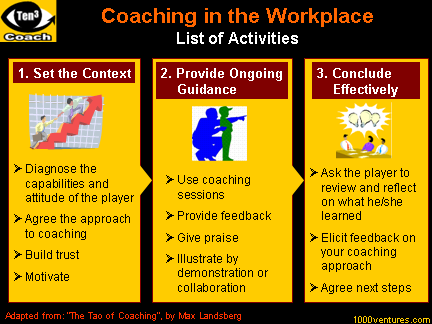
|
Coaching at Work: The Twin Concept
|
-
to help employees grow, and to enhance
their learning ability and performance
-
to increase the coach's effectiveness as a
leader
|
|
Increasing Role of Coaching at Work
The
→
new breed of leaders
 recognizes that in today's complex
business environment autocracy no longer works, yet the empowerment alone is
not enough. New
management model is a
→
synergy
of three roles: recognizes that in today's complex
business environment autocracy no longer works, yet the empowerment alone is
not enough. New
management model is a
→
synergy
of three roles:
❶
Manager
❷
Leader
❸
→
Coach.
According to Max Landsberg, the author of
The Tao of Coaching,
in the
new economy driven by
knowledge, new emphasis on people development and
employee empowerment is driven by several powerful forces:
-
Delayering – a trend toward reducing the number of management levels in
organizations' hierarchies. Growing importance of
cross-functional teams. Jobs and
roles are no longer prescribed and static, so no longer can bosses just go
on telling subordinates exactly what to do. Successful companies are now
those in which people communicate freely, cross-pollinate their ideas, and
learn new skills and habits from each other, and in which managers are also
coaches.
-
Changes in the labor market - people are more mobile, and the most
successful companies are focusing more on bringing out their employees'
potential in order to retain their best performers.
-
Rapidly changing business conditions, markets and technologies - company can
no longer rely on providing employees with regular off-the-job training
courses. Training now had to be continuous, on-the job, and just-in-time –
i.e. by coaching.
Two-Way Benefits of
Coaching
Coaching is a long-term strategy, but the benefits of
managerial coaching are two-way:
For employees:
improved
performance,
greater enthusiasm, and greater job satisfaction.
For managers: improved
communication,
motivation,
delegation,
employee empowerment,
planning, and monitoring skills
|